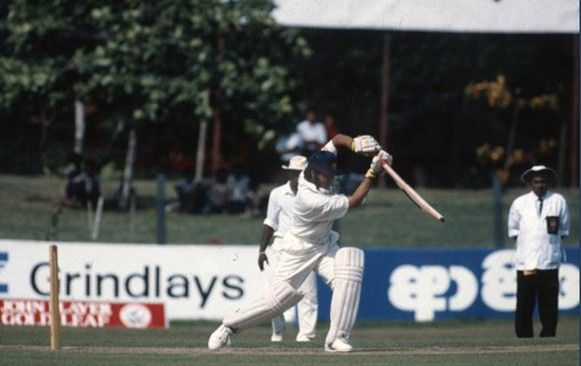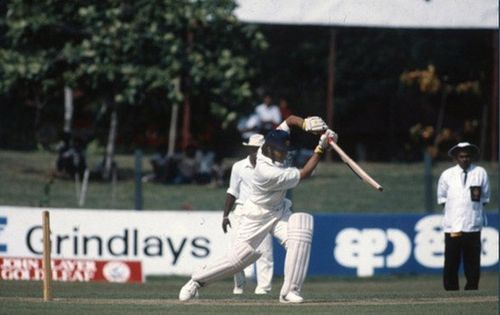
Remembering India's last away series win over Sri Lanka

India’s announcement of the squad for the upcoming tour of Sri Lanka has officially begun the countdown to yet another overseas excursion where India must look to register a series win – something India haven’t achieved in Sri Lanka in 22 years. There have been four trips to the island nation since a 1-0 victory in 1993, but India have been bested twice (2001, 2008), while the other two series were drawn (1997, 2010).
And now, India fly to Sri Lanka with a squad not particularly dissimilar to the one that made the journey across the border to Bangladesh in June. There was also a recall to the side for Amit Mishra, now 32, for the first time since a dismal performance in England in 2011.
Wriddhiman Saha is the only regular wicketkeeper in the squad as well, another risky gambit built on sand, one which India will hope is not exposed.
The only away victory of the 90s
India arrived in Sri Lanka in mid-1993 having defeated Zimbabwe by an innings in a one-off Test in Delhi in March. Prior to that, India had also whitewashed England 3-0 at home in February, with two of the wins coming by an innings.
India generally had a happy time of it at home in the 1990s, but their away form was dreadful – the albatross around their necks which prevented them from making that ever so important step from ‘good’ to ‘great’.
It had become an almost embarrassingly familiar pattern: welcome team to Delhi or Mumbai. Proceed to unleash batting strength. Pile up huge total. Crush opponent with bowling. Be hailed as heroes all over the country. Book ticket to foreign land. Arrive. Get summarily thrashed. Return with tail between legs and rotten tomato pulp all over face.
Many observers during this period dubbed India ‘Tigers at home, lambs abroad’, a tag which, several years later, first Sourav Ganguly and then Rahul Dravid worked hard to sever from their necks and cast aside.
India registered a 2-0 series win in England in 1986, their last Test match win outside Asia until Bulawayo in 2001. Following that triumph, India once again succumbed to their bad habits, recording precisely one Test match win on foreign soil in the entire decade of the 1990s. Yes, you read that right.
India played 38 separate Test matches away from home in the time spanning 1/1/90 to 31/12/99 and claimed a solitary victory, although a scheduled Test match in Dunedin, New Zealand in December 1998 was abandoned without a ball being bowled.
In 14 attempts to avoid defeat in the opening Test of a series abroad during this period, India only succeeded 6 times, giving them a success rate of 42.85%. Excluding one off Test matches (Harare 1992 and 1998, and Hamilton in 1994), this reads 4 times in 11 attempts at a rate of 36.36%.
Clearly, India struggled badly in countries not called India since England ’86. Which makes the visit to Sri Lanka in ‘93 an oddity, an outlier, a very un-India India performance. Because that’s where they recorded that single win.
And a series win abroad.
The only one between England 1986 and Pakistan 2004.
Stopping the trend, India go 1-0 up
It was a series full of drama and one of immense satisfaction for India, a rare moment of lustre in the cloudy skies of the ‘90s. The economy had opened up two years previously, and India proceeded to open Sri Lanka up.
The first Test at Kandy was an escape from the jaws of defeat, hardly due to any brilliance on India’s part. Sri Lanka were 0-1, then 6-2, and finally 8-3 until rain decided to barge in at the 50-minute mark with Asanka Gurusinha and Arjuna Ranatunga at the crease. It did not stop. And the match was drawn, the series beginning with a damp squib in more ways than one.
Vinod Kambli entered the series in the form of his life, peaks that he was never quite able to scale again. 224 against England in Mumbai was followed by a 227 against Zimbabwe in Delhi in the one-off Test. He picked where he had left off, scoring 125 in India’s first innings in the second Test at Colombo (SSC) as India piled up 366.
India then restricted Sri Lanka to 254 and it was time to give the bowlers a hammering. Sachin Tendulkar and Navjot Singh Sidhu didn’t disappoint. Both scored 104 as Azharuddin declared at 359/4, giving Sri Lanka a daunting target of 472 to chase.
A successful chase was unlikely, and the Lankans could only hope to force a draw at that stage. They were 86/2 at stumps on day four, and victory was within India’s grasp.
And yet, they so very nearly blew it. The Sri Lankans put their heads down and simply began tapping the ball, trying to play the day out. Most of the batsmen posted mind numbingly low strike rates, but their plan almost worked.
Aravinda de Silva held fort with a solid 93 and Sri Lanka were close to a monumental draw when India finally struck back. The bowlers pushed hard in the post-tea session, Anil Kumble catching Pramodya Wickramasinghe leg before to wrap up the match for India.
Though the margin of victory was significant (235 runs), India had left it late, almost allowing Sri Lanka to slip through their fingers.
The Test itself, though dramatic, was a sorry affair, an ugly disintegration of the “gentleman’s game”. The atmosphere was poisonous, with India appealing loudly and vociferously protesting some highly contentious umpiring decisions, on the suspicion that they were being unfairly targeted while the hosts were being let off easy. Sachin Tendulkar was one such victim in the first innings, serious questions being raised as to whether he had actually made contact with the ball when caught by Tillakaratne at short leg.
Vinod Kambli, however, was unable to contain his emotions and showed dissent when given out in the second innings. Things had got completely out of hand – match referee Peter Burge issued a harshly worded warning to both teams at the end of the match, singling out Kambli for a special dressing down pertaining to his conduct in the game.
Sachin, the breath of fresh air
The third Test at Colombo (PSS) petered out to a tame draw. Sri Lanka recorded scores in excess of 350 in both innings, while India only got to bat once. No matter, as Kambli scored yet another century. The Mumbai boys and childhood friends Kambli and Tendulkar had been imperious against the islanders, helping India to a rare win away from home and sealing the series comfortably.
Another point of interest for India was Sachin captaining the team. Azharuddin had the flu, so the Little Master led his country out on the last day of the third Test – the youngest captain of a Test team, although he was doing so in a temporary role.
The critical response to this change was mostly positive; in an ill-tempered series which poured water all over the ‘spirit of the game’, Sachin was the proverbial breath of fresh air, an interesting insight into the possible (and eventual) future of the Indian team.
Sachin spoke to Sportstar in September 1993 about this moment, and he made an interesting point:
“I was a little bit satisfied. But they played negative cricket and I hardly got a chance to play a commanding role you expect a captain to play. Yet I was more involved than I am normally.”
The hard-nosed Sri Lankans had decided to grind from the very beginning. But it is a testament to their strength that India overcame adversity in the form of controversial umpiring and hostility of local conditions to record a series win abroad, their last for eleven years. It was an all-too-brief glimpse at the potential of this team, which, disappointingly for Indian fans, proved to be just that for several years: a glimpse.
Nevertheless, the tour to Sri Lanka deservedly has a special place in the country’s collective cricketing memory.